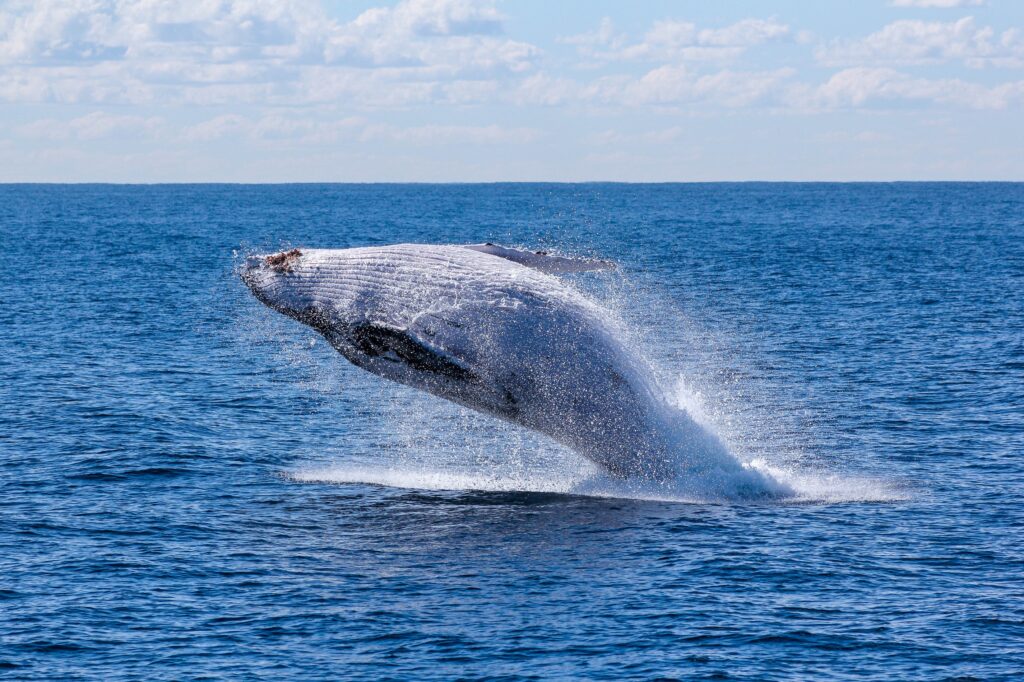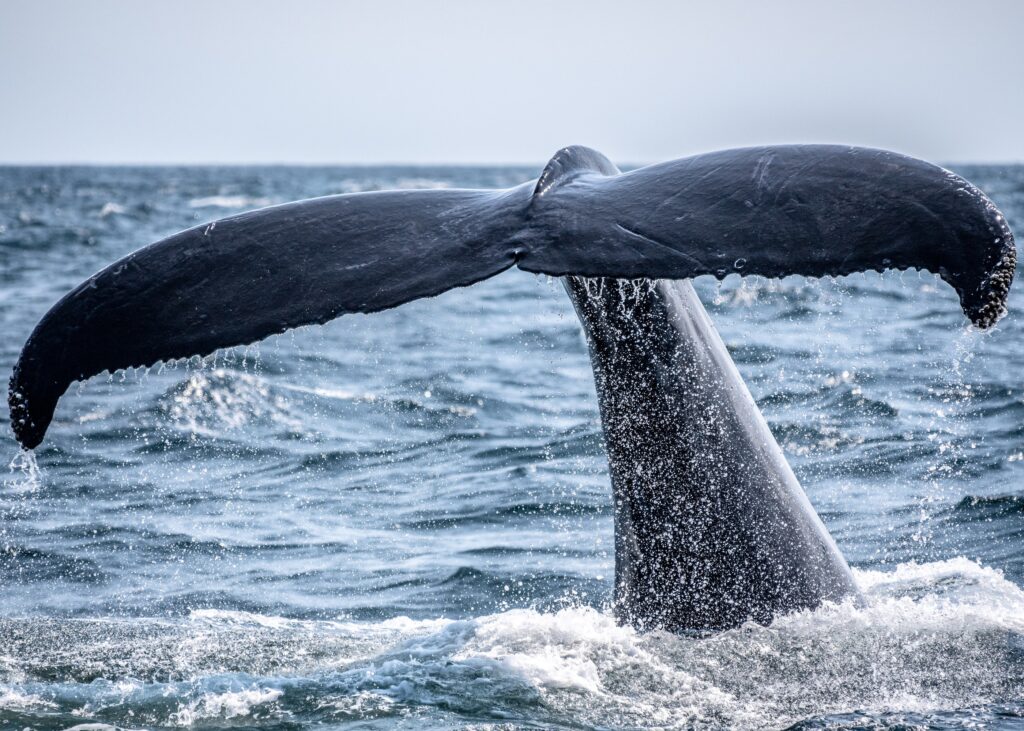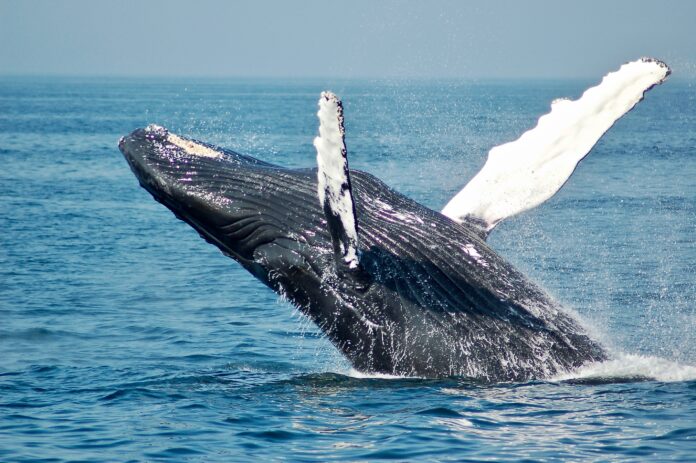
They have fins, live in the water, and can grow very large, but they are not fish! Although they are similar, whales are actually mammals, just like horses, dogs, cats, or humans.
In fact, whales, like dolphins, belong to the cetacean group.
Do you want to know more? In this article, we want to tell you about the fascinating world, habitat, behavior, and characteristics of whales. Stay with us!
What exactly is a “whale”?
Whales are the largest animals that have ever existed, capable of reaching thirty meters in length and weighing 150 tons. They belong to a group of marine mammals known as cetaceans and are distributed throughout the world’s oceans.
They are not fish because they are warm-blooded, breathe air through their lungs, and give birth to live calves that feed on their mother’s milk.
Although they have hair on their surface, it is very fine. The thermal insulation function is provided by the considerable layer of fat underneath their skin.
Origin and Evolution of Whales
So far, scientific research has found that whales have inhabited the planet for 55 million years. Thanks to their evolutionary abilities, they have adapted to different environments.
In fact, did you know that whales did not start their life in the water? The whales we see today look nothing like those of millions of years ago.
Today’s whales and cetaceans evolved 50 million years ago from a prehistoric ancestor that walked on land on four legs with hooves, about the size of a dog.
That is why its spine does not swing from side to side but up and down and its tail is horizontal, not vertical like a fish’s (or a shark’s), that’s why this is a notorious characteristic of whales.
Whale habitat
Although it is evident that they are found in the ocean, it should be noted that they live in areas where the water is warmer.
For this reason, it is common to see whales near the coasts in winter and in different regions of the world. Whales spend the winter near beaches.
However, larger whales live in cold regions such as the Arctic, and thanks to their high percentage of body fat, they are able to maintain their temperature by themselves.
Characteristics of whales
Although there are multiple types of whales with different qualities, they all share similar characteristics.
They are massive in size

Whales come in a variety of sizes and shapes, but they all have similar characteristics.
On average, whales measure between 15 and 17 meters and weigh between 50 and 80 tons. The blue whale, however, can measure 30 meters and weigh more than 170 tons.
The blue whale is the largest; the dwarf sperm whale is the smallest.
Compared to its body, its fins are not too big. In fact, its main motor for movement is its tail, which is very prominent and prominent on it. Usually, their body is full of parasites or barnacles that stick to their skin.
The eyes are small compared to the whale’s body size, and its mouth is a slit that goes from under one eye to the other as if it wanted to smile.
The heart of a whale is four-chambered and measures about the size of a golf cart but weighs about 180 kg.
Generally, female whales are somewhat larger than male whales.
Whales have hair!
This is a fact that not everyone knows! Whales have hair, but it is so fine and light that it seems non-existent, so they depend on their body fat to regulate their body temperatures.
Baby whales have more hair than adult whales, and when their body fat develops, their hair disappears.
Longevity
A whale’s life span is around 30 years, though it can be longer in some situations.
This number varies according to the different species and even according to sex. For example, in the case of killer whales, females live approximately ten years longer than males.
How many types of whales are there?

Baleen whales
Instead of teeth, baleen whales have another type of anatomical adaptation formed by parallel elastic plates that simulate baleen plates.
They have up to 600 baleen plates on the upper jaw and filter seawater through the baleen plates, and the baleen hairs capture fish, shrimp, and plankton.
They are generally larger than toothed whales and are usually solitary, although they occasionally gather in groups to feed.
Blue whale:
considered the most enormous whale in the world, it can measure up to 32 meters and weigh around 190 tons.
Grey Whale
they stand out for the whiskers on their mouths that allow them to detect what is going on around them.
Humpback whale:
known because of the humpback dorsal fin.
Minke whale:
it is the smallest of this type of whale, measuring 9 meters long and weighing about 7 tons, but its dorsal fins are very elongated.
Greenland whale:
its head is much larger than the rest of the body, but its main characteristic is its longevity and the way it hunts is similar to sharks.
Toothed whales
Toothed whales are freshwater animals, possessing perfectly aligned and sharp teeth, very useful for the consumption of their prey.
They have a much stronger social structure than baleen whales, often gathering in groups with a stable social structure.
Beluga whale:
it is whitish in color, has a bulging head and a crest instead of a fin.
Pilot whale:
most of them are dark black or dark gray, some with short fins and others with long fins.
Right whale:
they can weigh up to 100 tons, and measure up to 60 feet long, their head is covered with small crustaceans and their blowhole is V-shaped.
Narwhal whale:
the males are characterized by their long tusks.
Sperm whale:
it is the largest of all toothed whales. It has the most giant flippers and the largest brain size of any animal. Many people immediately think of the Moby Dick story when they see it.
Whale’s behavior
The behavior of whales often changes depending on where they live. However, there are some behavioral patterns present in all whale species.
- Whales are very social.
They live in groups of up to 4 individuals. They have a remarkable ability to learn and are very intelligent, especially killer whales. They are generally not aggressive, except when sharks, orcas, or humans get too close to their young, as the mothers are very protective.
And as they have no predators, they live peacefully, exploring their habitat without worry or fear.
- “Whale song”.
A well-known characteristic of whales is the emission and reception of sounds. Whales emit sounds in different frequencies and vibrations. They are generally grouped into two types: echolocations and vocalizations.
Through these sounds, whales explore their environment and determine the distance to a given object with astonishing accuracy. This helps them to orient themselves and to find their prey.
- Whales don’t sleep too much.
Although they are aquatic animals, they need the oxygen present in the air for life and their way of breathing is voluntary. This means that every time they take in air, they do it consciously since they have to leave the water to take in air outside.
For this reason, whales sleep resting half of their brain. So, while one half sleeps, the other half stays awake to make sure it breathes and stays alert to any threat in its environment.
- The Jump.
The most famous behavior of whales is their characteristic jumping. The most “jumping” are humpback whales. The purpose of these jumps is not clear; several hypotheses have been proposed, such as the elimination of parasites, warning possible intruders, attracting the attention of their conspecifics, or simply another form of communication.
What do whales feed on?

The feeding of whales depends on their structural characteristics. A classification that has to do with the food they eat distinguishes toothed whales and baleen whales.
Toothed whales:
have teeth in their jaws so, they are carnivorous and good hunters. They feed on large fish, seals, penguins, and sea lions in their path.
Baleen whales:
they have filaments, baleen, instead of teeth. Plankton, krill, fish eggs, crustaceans, and microorganisms make up their food chain. They need to ingest tons of these foods to satisfy themselves.
So, is it true that a whale could eat a person?
Actually, eating a human would be physically impossible for all whale species. Except for one, the sperm whale is the only species that could swallow something as big as a person.
But, according to National Geographic – “While it’s physically possible, it’s “a billion to one thing” for a sperm whale to swallow a human, in part because encounters are so rare.”
How do whales reproduce?
Whales practice polygamy so that they can mate with different partners during the same breeding season, thus increasing the female’s chances of conception.
In general, they gestate only one offspring at a time and have offspring every 2 to 3 years. They reach sexual maturity at seven to ten years of age, and gestation lasts 10 to 12 months.
However, the difference is determined by the species in question. For example:
- The dwarf whale has a gestation period of 10 months.
- The bowhead whale has a gestation period of 11 to 12 months.
- The blue whale has a gestation period of 10 to 12 months.
- The humpback whale has a gestation period of 11 months.
- The gray whale has a gestation period of 12 to 1 month.
Like any mammal, whale calves grow inside their mothers. They first stick out their flippers at the moment of birth and then stick out their heads, which is when the mother pushes her calf to the surface to take in air.
Endangered whales

More and more species are joining the lists of “animals at risk of extinction” and “lists of extinct animals” and unfortunately, some whales are on these lists.
The IUCN (International Union for Conservation of Nature) Red List includes four cetacean species and 18 subspecies classified as “Critically Endangered” such as the North Atlantic right whale (Eubalaena glacialis).
While in the “Endangered” list there are 11 cetacean species and the whales found in the list are the blue whale (Balaenoptera musculus), the North Pacific right whale (Eubalaena japonica), and the sei whale (Balaenoptera borealis).
Other species at risk include the Gulf of Mexico fin whale (Balaenoptera edeni), northern fin whale (Balaenoptera borealis), gray whale (Eschrichtius robustus), and the Humpback whale (Megaptera novaeangliae) subpopulation of Oceania, among others.
Why are whales endangered?
It is ironic that whales have no natural predators, yet they are in danger of extinction due to humans and the problems we have created.
Since the emergence in the 17th century of mass whaling for trade-in whale carcass parts and the destruction of their natural habitats, whales have been in trouble.
In addition, climate change, melting ice, plastic pollution.
In fact, UNESCO estimates that more than 100,000 marine mammals die from plastic pollution each year. Also, due to collisions with large vessels and accidental entanglements with fishing nets.
Annually, some 300,000 cetaceans are killed due to bycatch, and 1,000 baleen whales perish due to commercial whaling.
What are the solutions?
The global solution is to end all commercial whaling, but it is also necessary to fight against climate change, overfishing, and pollution, which also affect them.
But individually there are options such as “adopt a whale” through the World Wildlife Federation and donate to organizations dedicated to ending whaling.
You can also volunteer if you are in an area where you can be of help and most importantly, raise your voice, share, and make people aware of this problem.
Now you know more about whales!
We hope that this information and the characteristics of whales have immersed you in their extensive and exciting world.
The more we explore and observe the behavior of whales, the more we learn about them. In this way, we can help their ecosystem and give our support to preserve their species.
Whale Watching Sri Lanka – Experience of a Lifetime
Because of Sri Lanka’s many different nature reserves, there are all kinds of safari opportunities. For example, you can go in search of leopards, bears, and other special animals in Yala National Park, elephants in Kaudulla National Park, or snorkel with sharks around Pigeon Island. An entirely unique experience is whale watching in Sri Lanka. Depending on the season, this can be done at various places around the coast of Sri Lanka. An experience never to forget.
Whale watching Sri Lanka
Whale watching is best done early in the morning and possibly combined with other activities. For example, in Trincomalee, it is possible to continue with snorkeling around Pigeon Island. Make sure you have enough drinks and sunscreen in advance. Most whaleboat trips start around 6:30 in the morning.
Whale watching from a small boat
You get on a boat and head out on the water with one or more experienced whale watchers. Then you sail a few kilometers seaward and after that… it’s good to look around. That may seem like looking for a needle in a haystack, but the experienced local captains are extremely skilled. Because before you know it you are floating just a few meters from one or more whales.
For a while, they continue to swim around your boat, but once the graceful tail comes up… they wave you goodbye and dive back deep into the water. There is also a good chance that you will spot some dolphins. An experience we absolutely recommend.
Whale watching in Trincomalee
The best season for whale watching in Trincomalee is from April to October. In this period you have the best chance of seeing whales and dolphins. Moreover, the weather in this season is also the best and you have little chance of rain.
Special about whale watching in Trincomalee is the capacity of the boat. With a maximum of 6 people, you are on a small boat in the middle of the sea, which makes the whole experience even more intense. We were even lucky that there were only two of us on the boat. Do you have the opportunity to visit Trincomalee in the right season? Then this is the best whale watching experience.
Whale watching in Mirissa
The best season for whale watching in Mirissa is from December to April. Mirissa is the most famous place in Sri Lanka for whale watching. Not so much because you have a better chance of seeing whales, but simply because the south coast of Sri Lanka is more popular. Trincomalee in the east is relatively less known. So prepare yourself for several large boats taking to the water in the morning in Mirissa.
Sri Lanka whale watching costs
The cost of whale watching in Sri Lanka obviously varies by provider. Expect to pay around $30 to $40 per person, including pick-up from your hotel. The whale watching tour will be 5-6 hours. By Sri Lankan standards, this is quite a pricey outing, but when you compare it to American prices, it is rather cheap and well worth your money!
Experience of a lifetime
It’s not every day you see a whale, and by the way, it’s a great story to take home. It is therefore highly recommended to go on a whale watching boat trip during your stay in beautiful Sri Lanka!
